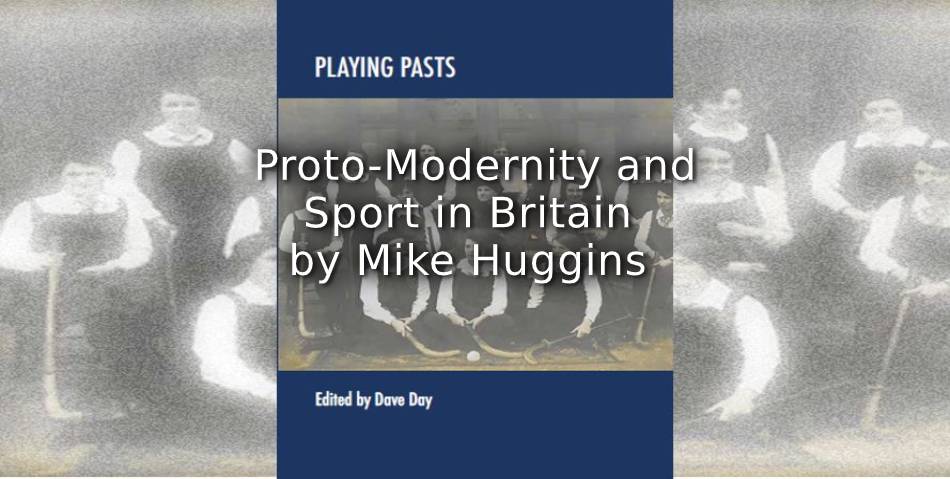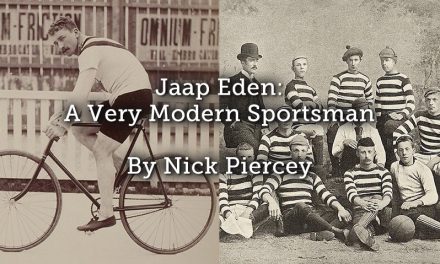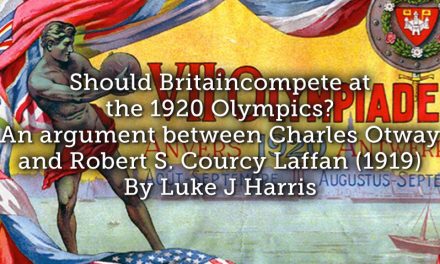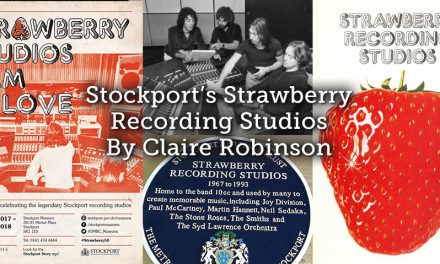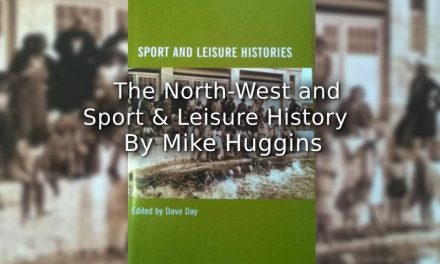Please cite this article as:
Huggins, M. Proto-modernity and Sport in Britain, In Day, D. (ed), Playing Pasts (Manchester: MMU Sport and Leisure History, 2020), 1-19.
ISBN paperback 978-1-910029-56-5
Chapter 1
______________________________________________________________
Proto-modernity and Sport in Britain
Mike Huggins
___________________________________________________________
Abstract
This chapter reviews and challenges some of the generally accepted assumptions about the relationship between sport and modernization during the long eighteenth century. It argues that many of the structural features of modern sport were already appearing, albeit in rather different form. It reviews the strengths and weaknesses of current historiography, and some of the problems of recent research, suggesting that they have contributed to misunderstandings in secondary works. It presents ‘proto-modern sport’ as a time during which the conditions for modern sport emerged: these included the development of a more commercialized sporting culture from quite early on; rapid population growth over the period; the expansion of provincial newspaper coverage; the expansion of the toll-road system; the all-pervasive wagering on sporting events such as horseracing, cricket, pugilism or cock-fighting; formal and informal associativity; and the emergence of a leisure class amongst the titled and gentry.
Keywords: Early Modern: Proto-modernity; Gambling; Associativity; Commercialization.
Introduction
The recent assertions of a ‘proto-modern’ phase of British sporting development, dating from c.1660s to the mid-nineteenth century, are beginning to problematize what have often been seen as the apparently rigid historical boundaries drawn between ‘modern’ and ‘pre-modern’ sports. This proto-modern phase can be defined as a gradual evolution of thought and socio-cultural atmosphere, during which sports adapted to changing historical contexts, preceding and paving the way for modern sport. It can be argued that the changes which took place during this period were crucial in creating ‘modern’ sport, and that modern sport was thus in its origins a Georgian rather than a Victorian phenomenon. This approach offers a way of opening up a rather different perspective on development in early modern Britain, a period when a new world of commercialized leisure emerged and sports like horse racing, boxing and cricket became serious components of Georgian social practices. Whilst there was still much participative more casual sporting play to be found, the emphasis was increasingly moving towards more organized physical activities, using more standardized rules, giving entertainment to spectators, often encouraging widespread gambling, and using (semi)professional players. Sporting culture had increased elements of commonality but was still differentiated by local, regional and sport-specific variations.
Sport and modernization
For the last three decades the emphasis in Anglophone historiography has been on the key concept of sporting ‘modernization’, often linked implicitly to an apparent expansion in the regularity of mass spectator sport. A series of scholars, including Elias, Dunning, Stockvis, Guttmann, Eichberg, Darbon and Vamplew have all explored this movement towards so-called ‘modernization’ over past centuries in some detail, albeit adopting a variety of theoretical approaches. They all contrasted ‘modern sport’ with earlier forms, and attempted to identify its key characteristics, although such approaches have been inclined to ignore regional developments and skated over specific historical contexts. They claimed that while such characteristics also appeared sporadically in earlier periods, in ‘modernity’ these characteristics interacted systematically, in widespread ways.[1]
Norbert Elias, and subsequent followers like Eric Dunning, argued for the ‘sportization’ of cultural activities and games through the development of codes of conduct and rules, and changing attitudes to the amount of violence acceptable.[2] Dunning and Ken Sheard, for example, showed fifteen ways older folk games contrasted with modern sport.[3] Guttmann emphasized the rational ‘sportification’ of physical culture.[4] This chronology of increased overall standardization of sports, allowed comparisons to be made, varied from place to place and from sport to sport, as sports began to develop and increasingly link together their key elements. Using a Weberian model, Guttmann argued that the formal-structural characteristics of modern sport were secularism, specialization, bureaucratization, rationalization, quantification, equality, and obsession with records.[5] Stockvis emphasized the international organization and control of sports as key.[6] Henning Eichberg likewise implied that sport’s emergence was part of broader modernization processes.[7] In 2014, Sebastien Darbon suggested there needed to be more stress on specific sporting spaces and the role of precise timings.[8] Joyce Kay and Wray Vamplew critiqued Guttmann’s approach and emphasized other factors including the availability of public information, professionalism and commercialization.[9]
Clearly, ‘modernity’ is a complex term. It has widely varied meanings and trajectories in every society. It is a contrast concept, taking its meanings from what it denies as much as what it affirms[10] Many sociological and historical texts still over-simply by contrasting ‘modern’ sport with what are described as ‘traditional’ or ‘pre-modern’ sports. Such terms are loose and problematic. All sporting traditions have to be invented and reinvented. Moreover, when does modernity actually begin? After all, every society in the past has thought of itself as modern. The criteria above were all ideal-type postulations. Even late-nineteenth-century individual sports rarely fulfilled all the criteria.
Even so, there has been a broad consensus amongst historians of sport that the middle years of the nineteenth century saw the emergence of a more recognizably modern, more achievement-oriented and commercial sporting culture. Though the chronology of these changes has been debated, and historical approaches should really adopt a rather more sceptical approach to chronology, change and continuity, generally it has been this mid-nineteenth time which arguably saw ‘the birth of modern sport’ or a global sporting ‘revolution’. Tranter describes the period as showing ‘a notable transformation in the scale and nature of Britain’s sporting culture’.[11] This was when, claimed Peter Borsay, ‘industrialization and urbanization bite so deeply that they stimulated a quantitative and qualitative change in leisure En masse, penetrating most regions and social classes’.[12]
The most significant feature of this change, often underemphasized by historians, was the quantitative shift that then appeared in the regularity, frequency and published calendars of contests as growing wealth and free time allowed spectator numbers to rise, encouraging a more consistently commercial approach. By contrast in the eighteenth century, commercialized contests were fewer, and in most towns usually relatively rare events each year, to be saved up for, to watch and to wager on, and to enjoy their ancillary attractions. There was insufficient money for such leisure available in the accessible region round about for this to be more regular. Many sporting events attracting spectators, such as rowing, pedestrianism, pugilism, or local football contests were often annual events, and very few towns had more than one annual race meeting.
London was an exception, a sporting market unique in terms of size, complexity, affluence and compactness, pioneering the longer-term trend towards the commercialization of sporting leisure, as other towns increasing aped its events and fashions. But even here, for cricket, probably the most regularly scheduled London event, between 1730 and 1773 there were only around five matches reported annually at London’s Artillery ground, and at Lord’s ground in 1787 only eight matches were played. Its cultural satellites, Epsom, Barnet, Egham, Ascot, Hampstead and Hounslow, all occasionally supported single annual race meetings.[13]
So, what was happening back in the long-eighteenth century? Here we still understand much less than we should, although our understanding is being slowly changed by revisionist new findings and discoveries. What is clear from work done so far on specific sports in the long eighteenth century is that many of the structural features of modern sport were already appearing, albeit in rather different form. In the case of the gambling-linked sport of horse-racing, to take just one example, local races were bureaucratized and run by race committees and clerks of the course; they were totally secular; based on the specialist skills of judges, jockeys and trainers; run by rules with large elements of commonality; with races often timed by interested individuals, and records of results kept. Attempts to maintain equality of competition through devices like handicapping and weight for height or age were also common.[14] Likewise, Conrad Brustrom and Tanya Cassidy argue that ‘by the 1780s cricket resembled the modern game in many key particulars’.[15]
Current historiography: a brief review
The complex intersections between sports and the multiple cultural, social, religious, economic and political contexts in which they were set within English society during the long eighteenth century have remained largely underexplored. A substantial body of detailed research is only slowly beginning to emerge. In recent years, most historians of sport have shown relatively little interest in those eras before the nineteenth century. The history of the early modern has attracted only a relative handful of researchers. This provides a stark comparison with the depth of research on the nineteenth and twentieth centuries.
Of the more substantive works available, some authors offered general overviews of sport during the early modern period that were rather more top-down in their approach, although also exploring popular amusements. There was a tendency to emphasize sport’s role in encouraging forms of associativity and social integration, sometimes within a class, and sometimes between classes. Dennis Brailsford Sport and Society: Elizabeth to Anne (London: Toronto: University of Toronto Press), in 1969 was stronger on the Tudor and Puritan phases than on the period from 1660 onwards. Brailsford largely focused on attitudes towards sport and exercise, and the relationship between social and intellectual movements and their impact on sport. His later works such as A Taste for Diversions: Sport in Georgian England (London: James Clark 1999) offered more thematic surveys and deepened our knowledge of early modern sport.[16] T.S Hendrick’s Disputed Pleasures: Sport and Society in Pre-industrial England (London: Greenwood Press, 1991), a functionalist approach to sporting life from 1066 onwards, includes only a chapter on Georgian sport, emphasizing sports’ twin role in reinforcing class and status divisions and providing a mechanism for social integration.
Derek Birley’s Sport and the Making of Britain (Manchester: Manchester University Press, 1993) included four chapters covering the period from 1603 to 1815. An idiosyncratic approach, almost entirely based on secondary reading, linking sport to the changing social and political scene, it offered limited new insights. It mainly emphasized the influence of the social and economic elite and was not always critically well received.[17]
Robert Malcolmson’s book Popular Recreations in English Society, 1700-1850 (Cambridge: Cambridge University Press, 1973) was long seen as the definitive study of eighteenth-century popular recreation. Adopting a cultural materialist Marxist approach, he argued that prior to the late eighteenth century, the labouring people of England enjoyed a rich, vital recreational sporting culture of athletic contests, ball games, games of skill and chance, animal sports and combat sports that was enmeshed with and derived its meaning from the economic and social patterns of rural, localized life. He suggested that these relationships then waned thanks to a combination of moral earnestness, social reform and industrial capitalism.
Richard Holt’s Sport and the British (Clarendon Press, Oxford 1989), clearly influenced by Elias’s work, described the early modern period as demonstrating ‘old ways of playing’ what he termed ‘traditional sports’ though he accepted that the time was one of changes as well as continuities. His coverage was relatively cursory (pp.12-28) and largely based on the very limited secondary sources then available, so it needs revision in the light of more recent work. His study contained significant numbers of inaccuracies, exaggerating the power of those bodies like the MCC and Jockey Club, whose influence was then highly geographically limited and sporadic, and suggesting that sports like bull-baiting and cock-fighting were ‘very common’ whereas both were already becoming regionally confined even in the second half of the eighteenth century.
Emma Griffin’s England’s Revelry: A History of Popular Sports and Pastimes, 1660-1830 (Oxford: Oxford University Press, 2005) was largely a study of the leisure of the common people, with its sporting focus predominantly focusing on the ways bullbaiting in the West Midlands came under challenge, together with some material on control of urban streets more generally and leisure in West Yorkshire, focusing particularly on contexts of space and power.
Though there are several scholarly articles on specific sports, too many to discuss here,[18] there are still only two sports that have received monograph-length attention: on cricket and horse-racing. Both had social elite involvement but dealt with the sports in cross-class ways. David Underdown, Start of Play: Cricket and Culture in 18th-Century England (London: Allen Lane, 2000), traced the origins of cricket in the south-east, its growing cross-class popularity, and the growth of clubs such as Hambledon and the MCC. He linked its growth to rural economic life and culture, aristocratic leisure and habits of political deference. More recently Mike Huggins in Horse Racing and British Society in the Long Eighteenth Century (Woodbridge: Boydell, 2018) explored race meetings, links with politics and gambling, rules and the running of meetings, the thoroughbred and breeding, and the professionalized world of jockeys, trainers and stable hands.
Edited collections are also now beginning to emerge. Sharon Harrow’s British Sporting Life and Culture in the Long Eighteenth Century (Farnham: Ashgate, 2015) covered a range of topics including recreational games, clothing, archery, tennis, celebrity, and boxing. Rebekka von Mallinckrodt and Angela Schattner Sports and Physical Exercise in Early Modern Culture: New Perspectives on the History of Sports and Motion (London: Routledge 2016) focused mainly on the period before 1700 and on early-modern Europe more broadly, covering British pugilism, sports venues, and competitive and non-competitive forms of sport, physical training and games.
Some of the problems of existing research
Conventional sports history chronology has proposed a picture of a shift from ‘traditional’ sporting life as it came under increasing attack in the eighteenth and early nineteenth century, supposedly accompanying the Industrial Revolution.[19] This led Richard Holt in 1989 to stress what he called ‘old ways of playing’ and ‘traditional games’ as characterizing British sport right up to the early nineteenth century, when these attacks had succeeded. In this prior period the research stress was often on agrarian, village, religion-linked sporting activities, supported tacitly by the elite.
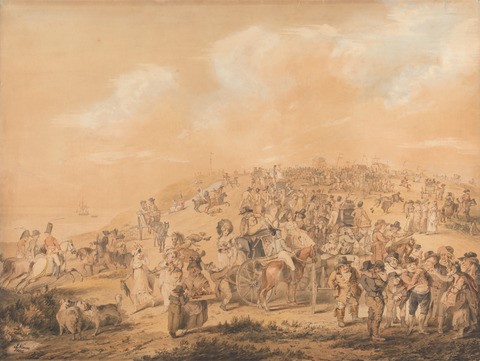
Figure 1. Brighton Races
Existing studies rightly demonstrated from contemporary published texts that there was opposition to sports of many kinds from middle-class social reformers and more puritanically inclined individuals. This material offered critical arguments about cruel sports. It pointed out that sports were associated with gambling and drinking, which could have adverse effects. They stressed that sports wasted time that could be devoted to productive work. But such testimony cannot be taken at face value, engaged as it was in cultural discourse and assertions of ideological identity. Such opposition, as with that concerning wakes and fairs, was most vociferous when events took place in town centres, with large crowds generating rowdiness and criminality and constraining local businesses and free passage. And the animal cruelty surrounding urban bull running and baiting was visible, unlike that of hunting where it remained largely unseen. Where historiography has been weak is that there has been insufficient recognition of the extent to which such literary critiques were those of a minority with often limited power to change wider attitudes. It was contested, challenged or simply ignored.
More recently there has been increased challenge to the conventional view that industrializing Britain over the long eighteenth century witnessed a sharp increase in the volume and intensity of elite criticism of working-class sports and pastimes. Griffin, for example, now suggests that while there was some ambivalence towards sport, there was a substantial degree of toleration. Many were indifferent and though there were some hostile voices, ‘the majority thought some measure of regulated diversion was to be encouraged’ so the idea of a’ decisive shift in attitudes towards traditional pastimes of the poor does not appear to be so well grounded as has long been assumed’.[20]
Existing research, especially that written from the 1970s until the late 1990s, has also distorted understandings by its common focus on what Elias and Dunning called ‘folk games’, and sports like folk football, rather than on any broader view of sport. Concentration on theories of the ‘civilizing process’ and the related issues of violence and social control have distracted historians of sport from wider issues. Change factors are more complex than that. Historical change in sport is a process with no clear fixed starting points, and there is general acceptance by sociologists that it is ‘uneven and prone to reversals’.[21] Sporting changes in Britain need to be related to multiple variables, to urban and rural sport; to regional differences, as in the different forms of wrestling in Cumbria or Cornwall, or the relatively greater success of cricket in southern England; to the degree of male and female participation (gender issues were neglected by Elias), or to social class as in sports like fox-hunting. The rise and fall of particular sports can be related to broader social attitudes, as in the case of cockfighting, or to mere fashion. Archery, for example, was popular in the 1660s, and then declined, with a few rural societies appearing only briefly, but then revived in the 1770s.
Individual sports have their own lifecycle, sometimes unrelated to broader leisure patterns. So, change in sport has often been an unhurried and gradual transition, with large elements of continuity. In his 1998 study, Neil Tranter showed clearly that there are usually uneven patterns of change and significant elements of continuity with earlier forms of sport.[22]
Current historiography has exaggerated not just the amount of opposition to sports more generally but also the successes that the opponents of sports claimed. Bull baiting and cockfighting were sports already in decline before they came under attack. When we look at their regional distribution, even in the second half the eighteenth century these were already confined largely to relatively small parts of England: cockfighting largely to northern England, and bullbaiting to parts of the midlands. As Griffin’s work shows, in most parts of the country bullbaiting simply disappeared with no evidence of any reason, and only in the west Midlands was it contested.[23]They were becoming unfashionable. Sports linked to the elite, such as cricket, hunting or horse racing, continued to thrive, as did some more popular sports. Wrestling matches, for example, were organized by innkeepers in several parts of England and commercialized, semi-professionalized and formalized from quite early on. In 1746, for example, at ‘The sign of the Wrestlers’ inn at Ipswich, a contest held on a December Monday was advertised between ‘the famous Daniel Hargrave’ and ‘the noted James Burgiss’ for a stake of twenty guineas.[24]
Likewise, seeking to identify any clear ‘great divide’ appears to be futile. The long period from 1660 through to the mid-nineteenth century should be rather seen as a long period of proto-modernity as features of modern sport slowly began to emerge, not in any consistent way, more in some sports rather than others. There were no dramatic moments of transition but rather slow, undramatic series of changes.
The key factors driving such change in the long eighteenth century were already accelerating urbanization and proto-industrialization; the attraction of gambling, not just to the elite, but across society more generally; the existence of a leisure class, largely but not entirely of landowners; commercialization; the advent of newspaper advertising; and better road communications. Each of these was developing with its own trajectory, but they helped drive the transformation of sport as interdependent trends within the macro-transformations taking place in British society from 1660 onwards. These factors came together to begin over time to create a growing demand for sport.
Proto-modern sport: key factors
Economists have identified a phase in the development of modern industrial economies that preceded and created conditions for the development of fully industrialized societies. This was ‘proto-industrialization’. [25] Historians of sport now need to explore much more fully that period of proto-modernity in which the conditions for modern sport emerged. Certainly, it is already clear that the threshold for the beginnings of modern sport, at least in some cases and in some regions, can be pushed well before 1800. It perhaps began to emerge over a long period following the hiatus caused by the Civil War and the stress on Puritanism during the Commonwealth. It might even be pushed further back. Taking a cultural rather than a materialist view, the growth of individualism, alongside new forms of community created by the embryonic factory system, and a more general cultural transformation of society, economy and personality appeared concurrently with the scientific revolution and the Enlightenment, finally crystallizing as the industrial revolution spread across England. Early industrial developments in England can be perceived even in 1700 and grew in pace from the 1750s. Even so, as Wray Vamplew points out, the relationship of sport’s expansion to industrial developments is less clear than scholars have claimed and needs to be rethought. Stobbart has shown that in many areas the patterns of urban growth appear to have preceded the period of maximum industrial growth by some forty to fifty years and this forces us to rethink the relationship between industrial and urban development.[26]
What are the key factors that influenced the development of modern sport? Some time ago Allen Guttmann argued that modern sport could be viewed as a by-product of the scientific revolution of the European enlightenment. Certainly, some sports picked up on scientific theories. In horse racing, for example, the eighteenth century saw increased interest in scientific farriery and thoroughbred breeding records based on heredity.
Modernity is often tied to industrialization, but the industrialization process had a complex chronology, with much variation in its take-up within and between countries and its beginnings found even in the eighteenth century, often in rural rather than urban contexts. As Wray Vamplew (2016) has recently pointed out, ‘the role of industrialization is too often taken as a chronological correlation without the causal relationship being fully specified’.[27] The process was long and drawn out, rather than universal, sweeping, and all-pervasive. Initially it was limited, diverse, and regionally confined. However, as Walton has made clear, the protoindustrial characteristics of what would become cotton Lancashire were already discernible in the seventeenth and eighteenth century. Early industrialization provided more reliable income for some workers over rather longer time frames.[28] However this was not widespread until the late nineteenth century.
Adrian Harvey had implied that the beginnings of a commercial sporting culture in Britain appeared in the period 1793 to 1850.[29] He certainly produced much evidence of commercialized sport at that time, but this was not a major shift. More recently there has been an increased emphasis on the commercialisation of sport in the long eighteenth century. Had Harvey explored the earlier period he would have found that the commercialization of leisure was already established in Britain in the eighteenth century and sport played its part.[30] Commercialization has been a feature of sports during many periods, and in many places, across the century, although the proportion of commercialized sports to non-commercialized sport has certainly increased in the past two centuries. However, mass spectator sporting events were much more sporadic in this earlier period.
Equally significant, in my view is that the population of Britain grew rapidly during the early modern period, from around five million people in 1700 to nearly nine million by 1801. Populations were becoming more concentrated in some market and county towns even at the beginning of the eighteenth century. London’s growth was rapid and unprecedented, but population growth was also rapid in the counties round London (Middlesex, Surrey, Kent and Essex), the larger regional trading centres and county towns like Newcastle, Liverpool and York, and the flourishing new industrial towns like Manchester or Leeds.[31] Here, as with what have been called the ‘residential leisure towns’,[32] there was more sustained interest in sports. London labourers’ wages were twice as high as they were elsewhere, and through the course of the eighteenth century, real wages grew rapidly for workers in Lancashire, the North East, parts of Staffordshire and West Yorkshire.[33] These towns possessed remarkably young populations. Young people were drawn to urban areas by the lure of regular and full-time employment, and apprenticeship flourished. So, it is unsurprising that these began to provide early forms of more commercialized sport. In the rural south east, rural incomes started to edge up in the early 1700s, giving men more free time for cricket.[34]
Sports attracted crowds and cash. Constellations of demand for sports like horse racing emerged quite early on. There was an increasing concentration of merchant wealth, and a gentry and aristocratic group wealthy though land, agriculture and mineral deposits, with time, spare capital and by no means risk averse.
Other major factors also aided the increased commonality of both commercial and social forms of sport. Firstly, the expansion of provincial newspaper coverage in the first decades of the eighteenth century allowed forthcoming sporting events to be widely publicized. London newspapers were in wide circulation in the first decade of the eighteenth century and by 1708 Worcester, Bristol, Stamford, and Norwich all had provincial presses. Newspaper publicity, and the inclusion of sporting advertising, with its hyperbole and exaggeration, helped transform sporting events like horse racing as well as signifying their politeness to the burgeoning middling groups. They were, as Michael Harris has shown, ‘a core element in the construction of an eighteenth-century public sphere’, since readers could supply news reports and advertising.[35]
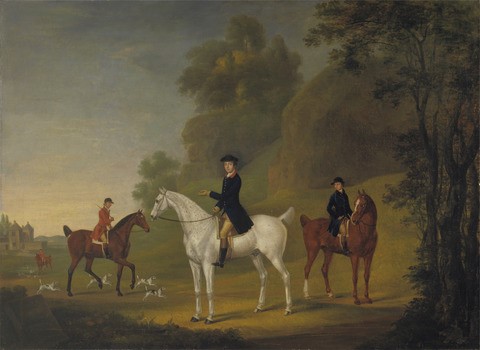
Figure 2. Lord Bulkeley
The expansion of the toll road system, from the mid-1700s, coupled with faster and more regular coach transport, produced far more efficient national and regional communications network, allowing spectators and professional sportsmen to travel from further afield. Sports like horse racing, coursing, hunting and cockfighting encouraged the association of like-minded individuals, meeting together at inns and taverns, country houses, hunting lodges and elsewhere. Indeed, Stephan Szymanski locates English sport’s move towards modernity’s origin in formal eighteenth-century associativity and sports club creation, not in nineteenth-century industrialization.[36] The Journal of Sport History devoted a special forum to the topic in 2008, and more recently Huggins has argued that gambling on sporting events and informal association were initially much more important than formal club formation in sports’ spread. [37] In some more vibrant rural parishes sports such as cricket, wrestling or cockfighting could become strong focal points of communal identity. But it was the Georgian gentry’s pervading culture of sociability, and the various voluntary elite associations and clubs they formed, which played a more important role in helping to construct an emergent sporting culture. The first formally organized English sports clubs were emerging even in the 1600s, although their membership was often linked to the leisured classes, often aristocrats and the gentry. In archery there were clubs like the Finsbury Archers (founded 1652), the Scorton Archers (1673), or Edinburgh’s Royal Company of Archers (1676).[38] In horse racing, Newmarket’s Jockey Club was probably founded c 1717.[39] Horse racing provided a convivial focal point for a wide variety of associational cultural forms, highly useful for political interactions, drinking, gambling, and other sporting events such as cock-fighting, pugilism or wrestling. Subscription hunt clubs were beginning to appear by the 1730s and were fashionable by the 1770s though many hunts continued to be run by a single master.[40] By the later eighteenth-century, hunt clubs were even sometimes sponsoring race meetings, especially in the north. An early London cricket club appeared in 1722 and by the 1750s there were growing numbers of formal cricket clubs appearing in London and the south-east, the major ones with some high-ranking aristocratic membership, although teams were made up of players from radically different social backgrounds.[41]
Some of the features of early modern sport were driven by the existence of a wealthy leisure class of aristocrats, gentry, and others, whose interests were partly urban, through their town houses and London life, but also rural on their estates. Rural sporting developments stimulated inter alia the development of sporting equipment, semi-professional sports people, sporting associativity and rule development. Coursing clubs with formal rules and membership emerged from informal hare coursing in the later eighteenth century. Deer and fox hunting were widely popular. So were shooting and angling, confined by game laws to landlords and estate owners.
Of the factors most vital in driving sport’s progress, one was associativity. The other key factor was gambling. Gambling was ubiquitous among all social classes in England in the eighteenth century, and in sport, excitement and economic investment were often inextricably linked. Probability theory emerged during the Enlightenment, with several published works on card games and sport. Indeed in 1792 the early advertisements for the monthly Sporting Magazine expected interest from ‘the disciples of de Moivre, the votaries of Diana and the frequenters of Newmarket’. De Moivre was a French mathematician whose book on probability theory, The Doctrine of Chances, first published in 1718, was prized by gamblers (Diana was the goddess of hunting, and Newmarket the home of the Jockey Club).
For some, driven by needs for cultural capital or hard cash, winning at all costs led to match-fixing. The members of the aristocracy and gentry had the resources and immense appetite for gambling to make high wagers on a regular basis, on a wide range of sports, including horse racing, boxing, cricket and pedestrianism.[42] Those contests involving high stakes attracted interest, crowds and more gambling. By the late eighteenth century even coursing matches between regional clubs were gathering crowds of several hundred people, often with large stakes placed upon the outcome.[43]
Should it be seen as a separate period?
In the case of Britain at least, scholars are now beginning to accept that the early modern period saw the origins of modern sport and in Britain, the nation most rapidly industrializing, it should be characterized as an era of proto-modernity, an ‘early modern’ period in terms of sport. Indeed, some historians are now trying to argue that it should be seen as a separate and conceptually distinct period. In 2009 Wolfgang Behringer argued that the early modern period was ‘not merely as an independent era in the history of sport, but as the formative period of modern sport’. He suggested that the early modern period could be regarded as ‘a distinct epoch in the history of sport, since its early days were marked by the advent of important new sports, followed by their decline from the mid-eighteenth century’.[44] He emphasized the high levels of institutionalization and standardization of sports in England. In 2011, Tomlinson and Young followed Behringer in suggesting that modern sports emerged from developments in the early modern era rather than as a by-product of industrialisation. Sport became increasingly institutionalized by the creation and codification of rules, the building of dedicated sport spaces, a European-wide trade in sports equipment, and the emergence of a professional class of athletes, coaches and officials.[45] In 2016, Mallincdrodt and Schattner likewise portrayed it as an ‘independent and formative era’.[46]
How convincing is this argument? Clearly, it was a period which had many of the features of modern sport, with rules for sports from horse-racing and boxing to coursing and real tennis being codified, many commercial features of spectacle and performance, and strong links to gambling in many sports. At the same time, however, it is difficult to see the period as a distinct epoch in the history of sport, when there was no distinct break, no clearly defined period. As early as 1991, Dennis Brailsford argued that modern sport was merely an extension of pre-existing sporting practices that changed to suit different social, economic and political circumstances.[47] And there are still major problems with the existing historiography.
How should we move forward?
We still know relatively little about the period. Much is still unknown. Much needs to be re-examined. If we are to push back the current boundaries of our knowledge, we need to widen significantly the range of our source material, move beyond the more prescriptive literature and gain a much better sense of what sport encompassed, what it meant to people, and the extent of changes and continuities. There are many sports during the long eighteenth century that have received only cursory attention, from more popular sports such as wrestling or pedestrianism, to elite sports such as hare coursing and fishing. What becomes clear from the limited work done thus far is that the early modern age is much more complex that many writers have indicated. A strong thread of continuity clearly ran through the period. There were groups, often cross-class that showed a strong resistance to change. There were social reformers and religious puritans who were strongly opposed to violence, blood sports, gambling and the drinking associated with many sporting events. While the attitudes, beliefs and actions of the powerful, privileged and rich influenced sporting developments of some sorts, the middling groups and the mass of the population also played a proactive role in many cases.
There are many challenges for those historians willing to explore the proto-modern age, quite apart from the limitations of existing historiography. Major problems concern the sheer breadth, depth and complexity of the sources available to establish a far wider historical context, develop a more grounded chronology and a fuller understanding of the period, and gain a sense of the distinctiveness of and interconnections between different forms of sport. Newspapers increased sporting content only slowly from the early eighteenth century as they began to recognise the commercial potential of such reportage. Horse-racing provided annual calendars of more important meetings from 1728 onwards. The first sport-focused magazine, The Sporting Magazine, only began in 1792. This means that other sources assume much more importance to the historian.
Little-read novels, stage plays, published memoirs and other formal written sources become far more central. Surviving family archives tend to originate from gentry and aristocratic families rather than the poor, but contain letters about sporting events, financial records and accounts for breeding, game-keeping and hunting, bills from sporting professionals such as jockeys and trainers, details of sporting wagers, and other accounts. Wills provide much detail about the later life of sportsmen, their wealth and possessions, and their familial and social connections. However, as ever with such material in hand-written form, graphical features and massive variations in spelling create their own demands. Urban records, especially the more detailed ones of county towns like Chester or York likewise contain much relevant material. Georgian paintings and prints, and surviving sporting architecture become key visual sources, despite the challenges of reading contemporary meanings and creating our own interpretations. Court records, such as those of the Old Bailey which offer transcripts of what was said in court, allow us to see how some sports featured in everyday life. Coroners’ reports allow the historian an insight into the contexts of some sporting deaths.
The potential is there. Where are the historians to realize it?
References
[1] Allen Guttmann, From Ritual to Record: The Nature of Modern Sport (New York: Columbia University Press, 1978),172.
[2] Norbert Elias and Eric Dunning (eds.), Sport and Leisure in the Civilizing Process (Oxford: Basil Blackwell, 1986).
[3] Eric Dunning and Ken Sheard, Barbarians, Gentlemen and Players: A Sociological Study of Rugby Football (Oxford: Martin Robertson, 1979).
[4] Guttmann, From Ritual to Record; Richard Guilianotti, Sport: A Critical Sociology (London: Polity Press, 2005).
[5] Guttmann, From Ritual to Record; Allen Guttmann, Sports: The First Five Millenia (Amherst: University of Massachusetts Press, 2004), 4-5.
[6] R. Stockvis, ‘Sport and Civilisation: Is Violence the Central Problem’, in Sport and Leisure in the Civilising Process ed. Eric Dunning and Chris Rojek (Basingstoke: Macmillan, 1992), 134.
[7] See Susan Brownell, ‘Thinking Dangerously: The Person and his Ideas’, in Body Cultures: Essays on Sport, Space and Identity, ed. Henning Eichberg (London: Routledge, 1998), 28-9.
[8] Sebastian Darbon, Les Fondements du Systeme Sportif (Paris: L’Harmattan, 2014).
[9] Joyce Kay and Wray Vamplew, ‘A Modern Sport? ‘From Ritual to Record’ in British Horseracing’, Ludica 9 (2003): 125-129.
[10] Krishnan Kumar, The Rise of Modern Society: Aspects of the Social and Political Development of the West (London: Blackwell, 1988); Jim McGuigan, Modernity and Post-modern Culture (Maidenhead: Open University Press, 2006).
[11] Neil Tranter, Sport, Economy and Society in Modern Britain 1750-1914 (Cambridge: Cambridge University Press, 1997), 13. Dennis Brailsford, Sport, Time and Society: The British at Play (Abingdon: Routledge, 2014), 65 saw it as starting in the 1870s.
[12] Peter Borsay, A History of Leisure (Basingstoke: Palgrave, 2006).
[13] Mike Huggins, Horse Racing and British Society in the Long Eighteenth Century (Woodbridge: Boydell, 2018), 69.
[14] See Huggins, Horse Racing and British Society; Joyce Kay and Wray Vamplew,’ A Modern Sport? From Ritual to Record in British Horseracing’, Ludica 9 (2003): 125-139.
[15] Conrad Brustrom and Tanya Cassidy, ‘Scorn Eunuch Sports’: Class, Gender and the Context of Early Cricket’, Journal for Eighteenth-Century Studies 35 no. 2 (2012): 226.
[16] Dennis Brailsford, British Sport: A Social History (Cambridge: Lutterworth Press, 1992); Brailsford Sport, Time and Society.
[17] See for example J. K. Walton, The English Historical Review, CXI, no. 44 (1996): 556; Wray Vamplew, History 80, no. 258 (1995): 156-7.
[18] For a recent example see Mike Huggins, Early Modern Sport’ in The Oxford Handbook of Sport History, ed. Robert Edelman and Wayne Wilson (Oxford: Oxford University Press, 2017): 113-127
[19] Robert Malcolmson, Popular Recreations in English Society 1700-1850 (Cambridge, Cambridge University Press, 1973).
[20] Emma Griffin, ‘Wholesome Recreations and Cheering influences. Popular Recreations and Social Elites in Eighteenth Century Britain’ in British Sporting Literature and Culture in the Long Eighteenth Century ed. Sharon Harrow (Farnham: Ashgate, 2015), 19-34.
[21] Patrick Murphy, Ken Sheard and Ivan Waddington, ‘Figurational Sociology and its Application to Sport’, in The Handbook of Sports Studies ed. J. J. Coakley and Eric Dunning (London: Sage, 2000), 104.
[22] Tranter, Sport, Economy and Society.
[23] Emma Griffin, England’s Revelry: A History of Popular Sports and Pastimes 1660-1830 (Oxford: Oxford University Press, 2005), 223.
[24] Ipswich Journal, 17 December 1746.
[25] For an early study of the literature see L A Clarkson, Protoindustrialization. The First Phase of Industrialization (London: Macmillan, 1985).
[26] Jon Stobart, ‘An Eighteenth-Century Revolution? Investigating Urban Growth in North-West England, 1664–1801’, Urban History 23, no. 1 (1996): 26-47.
[27] Wray Vamplew, ‘Sport, Industry and Industrial Sport in Britain Before 1914: Review and Revision’, Sport in Society 19, no. 3 (2016): 340-55.
[28] J k Walton, ‘Protoindustrialization and the First Industrial Revolution in Lancashire’ in. Regions and Industries: A Perspective on the Industrial Revolution in Britain ed. Pat Hudson (Cambridge: Cambridge University Press, 1989), 42.
[29] Adrian Harvey, The Beginnings of a Commercial Sporting Culture in Britain 1793-1850 (Aldershot: Ashgate, 2004).
[30] J. H. Plumb, The Commercialisation of Leisure in Eighteenth Century England (Reading: Reading University Press, 1973).
[31] Peter Clark ed. The Transformation of English Provincial Towns, 1600–1800 (London: Hutchinson,1984).
[32] Jon Stobart and L Schwarz, ‘Leisure, Luxury and Urban Specialization in the Eighteenth Century’, Urban History 35, 2 (2008): 216-236. Residential leisure towns included Bath, Berwick, Beverley, Birmingham, Boston, Bristol, Bury St Edmunds, Cambridge, Canterbury, Chester, Chichester, Colchester, Coventry, Derby, Doncaster, Dover, Durham, Exeter, Gloucester, Hereford, Hull, Ipswich, Lancaster, Leeds, Leicester, Lewes, Lincoln, Liverpool, Lynn, Manchester, Monmouth, Newark, Newcastle, Northampton, Norwich, Oxford, Peterborough, Plymouth, Portsmouth, Preston, Reading, Rochester, Salisbury, Shrewsbury, Southampton, Stafford, Stamford, Wakefield, Winchester, Windsor, Worcester, Yarmouth, York.
[33] E.W. Hunt and F.W. Botham, ‘Wages in Britain During the Industrial Revolution’, Economic History Review 40 (1987): 380-99.
[34] David Underdown, Start of Play: Cricket and Culture in 18th-Century England London: Allen Lane, 2000).
[35] Michael Harris, ‘Sport in the Newspapers before 1750: Representations of Cricket, Class and Commerce in the London Press’, Media History 4, 1 (1998): 19-28.
[36] Stefan Szymanski, ‘A Theory of the Evolution of Modern Sport’, Journal of Sport History 35, no.1 (2008): 4;
[37] Journal of Sport History 35, no. 1 (2008); Mike Huggins, ‘Associativity, Gambling and the Rise of Proto-modern British Sport’, Journal of Sport History (forthcoming).
[38] Linda Troost, ‘Archery in the Long Eighteenth Century’ in British Sporting Literature and Culture in the Long Eighteenth Century, ed. Sharon Harrow (Farnham: Ashgate, 2015), 105-124.
[39] Huggins, Horse Racing and British Society, 12.
[40] See Newcastle Courant, 17 May 1737. Subscription hunts were becoming fashionable by the 1770s.
[41] Rob Light ‘Cricket in the Eighteenth Century’, in The Cambridge Companion to Cricket, ed. Antony Bateman and Jeffrey Hill (Cambridge, Cambridge University Press, 2015), 26-39.
[42] For gambling on horseracing see Huggins, Horse Racing and British Society, 122-152.
[43] Emma Griffin, Blood Sport. Hunting in Britain since 1066 (London: Yale University Press, 2007), 118.
[44] Wolfgang Behringer, ‘Arena and Pall Mall: Sport in the Early Modern Period’, German History, 27, no. 3 (2009): 333, 357.
[45] Alan Tomlinson and Christopher Young, ‘Towards a New History of European Sport’, European Review, 19 (2011): 487-507.
[46] Rebekka Malinckrodt and Angela Schattner, eds Sports and Physical Exercises in Early Modern Culture (London: Routledge, 2015).
[47] Brailsford, British Sport: A Social History.

